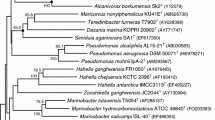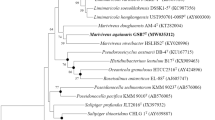Abstract
A novel actinobacterium, designated strain MSW-19T, was isolated from a seawater sample in Republic of Korea. Cells were aerobic, Gram-positive, non-endospore-forming, and non-motile cocci. Colonies were circular, convex, opaque, and vivid yellow in colour. A phylogenetic tree based on 16S rRNA gene sequences exhibited that the organism formed a distinct clade within the radius encompassing representatives of the family Propionibacteriaceae. The phylogenetic neighbors were the type strains of the genera Friedmanniella, Microlunatus, Micropruina, Propionicicella, and Propionicimonas. Levels of 16S rRNA gene sequence similarity between the isolate and members of the family were less than 95.3%. The cell wall peptidoglycan of the organism contained LL-diaminopimelic acid as the diagnostic diamino acid. The isolate contained MK-9(H4) as the predominant menaquinone, ai-C15:0 as the major fatty acid and polar lipids including phosphatidylglycerol, phosphatidylethanolamine, and an unknown phospholipid. The G+C content of the DNA was 69.6 mol%. On the basis of the phenotypic and phylogenetic data presented here, the isolate is considered to represent a novel genus and species in the family Propionibacteriaceae, for which the name Ponticoccus gilvus gen. nov., sp. nov. is proposed. The type strain is strain MSW-19T (= KCTC 19476T= DSM 21351T).
Similar content being viewed by others
References
Akasaka, H., A. Ueki, S. Hanada, Y. Kamagata, and K. Ueki. 2003. Propionicimonas paludicolagen. nov., sp. nov., a novel facultatively anaerobic, Gram-positive, propionate-producing bacterium isolated from plant residue in irrigated rice-field soil. Int. J. Syst. Evol. Microbiol. 53, 1991–1998.
Bae, H.S., W.M. Moe, J. Yan, I. Tiago, M.S. Da Costa, and F.A. Rainey. 2006a. Brooklawnia cerclae gen. nov., sp. nov., a propionate-forming bacterium isolated from chlorosolvent-contaminated groundwater. Int. J. Syst. Evol. Microbiol. 56, 1977–1983.
Bae, H.S., W.M. Moe, J. Yan, I. Tiago, M.S. Da Costa, and F.A. Rainey. 2006b. Propionicicella superfundiagen. nov., sp. nov., a chlorosolvent-tolerant propionate-forming, facultative anaerobic bacterium isolated from contaminated groundwater. Syst. Appl. Microbiol. 29, 404–413.
Collins, M.D. 1985. Analysis of isoprenoid quinones. Methods Microbiol. 18, 329–366.
Cui, Y.S., W.T. Im, C.R. Yin, D.C. Yang, and S.T. Lee. 2007. Microlunatus ginsengisoil sp. nov., isolated from soil of a ginseng field. Int. J. Syst. Evol. Microbiol. 57, 713–716.
Delwiche, E.A. 1957. Family XI Propionibacteriaceae, p. 569. In R.S. Breed, E.G.D. Murray, and N.R. Smith (eds.), Bergey’s manual of determinative bacteriology, vol. 7. Williams and Wilkins, Baltimore, USA.
Felsenstein, J. 1981. Evolutionary trees from DNA sequences: a maximum likelihood approach. J. Mol. Evol. 17, 368–376.
Felsenstein, J. 1985. Confidence limits on phylogenies: an approach using the bootstrap. Evolution 39, 783–791.
Felsenstein, J. 1993. PHYLIP (phylogeny inference package), version 3.5c. Department of Genetics, University of Washington, Seattle, USA.
Fitch, W.M. 1971. Towards defining the course of evolution: minimum change for a specific tree topology. System. Zool. 20, 406–416.
Hopwood, D.A., M.J. Bibb, K.F. Chater, T. Kieser, C.J. Bruton, H.M. Kieser, D.J. Lydiate, C.P. Smith, J.M. Ward, and H. Schrempf. 1985. Genetic Manipulation of Streptomyces: a Laboratory Manual. John Innes Foundation, Norwich, UK.
Jukes, T.H. and C.R. Cantor. 1969. Evolution of protein molecules, p. 21–132. In H.N. Munro (ed). Mammalian Protein Metabolism, Academic Press, New York, N.Y., USA.
Jung, S.Y., H.S. Kim, J.J. Song, S.G. Lee, T.K. Oh, and J.H. Yoon. 2007. Aestuariimicrobium kwangyangense gen. nov., sp. nov., an LL-diaminopimelic acid-containing bacterium isolated from tidal flat sediment. Int. J. Syst. Evol. Microbiol. 57, 2114–2118.
Kroppenstedt, R.M. 1985. Fatty acid and menaquinone analysis of actinomycetes and related organisms, p. 173–199. In M. Goodfellow and D.E. Minnikin (eds.). Chemical Methods in Bacterial Systematics, Academic Press, London, UK.
Lee, H.K., J. Chun, E.Y. Moon, S.H. Ko, D.S. Lee, H.S. Lee, and K.S. Bae. 2001. Hahella chejuensis gen. nov., sp. nov., an extracellular-polysaccharide-producing marine bacterium. Int. J. Syst. Evol. Microbiol. 51, 661–666.
Lee, D.W. and S.D. Lee. 2008. Tessaracoccus flavescens sp. nov., isolated from marine sediment. Int. J. Syst. Evol. Microbiol. 58, 785–789.
Lee, S.D. 2007. Nocardioides furvisabuli sp. nov., isolated from black sand. Int. J. Syst. Evol. Microbiol. 57, 35–39.
Lee, S.D. and S.J. Kim. 2007. Aeromicrobium tamlense sp. nov., isolated from dried seaweed. Int. J. Syst. Evol. Microbiol. 57, 337–341.
Maszenan, A.M., H.L. Jiang, J.H. Tay, P. Schemnn, R.M. Kroppenstedt, and S.T.L. Tay. 2007. Granulicoccus phenolivorans gen. nov., sp. nov., a Gram-positive, phenol-degrading coccus isolated from phenol-degrading aerobic granules. Int. J. Syst. Evol. Microbiol. 57, 730–737.
Maszenan, A.M., R.J. Seviour, B.K. Patel, P. Schumann, and G.N. Rees. 1999a. Tessaracoccus bendigoensis gen. nov., sp. nov., a Gram-positive coccus occurring in regular packages or tetrads, isolated from activated sludge biomass. Int. J. Syst. Bacteriol. 49, 459–468.
Maszenan, A.M., R.J. Seviour, B.K. Patel, P. Schumann, J. Burghardt, R.I. Webb, J.A. Soddell, and G.N. Rees. 1999b. Friedmanniella spumicola sp. nov. and Friedmanniella capsulate sp. nov. from activated sludge foam: Gram-positive cocci that grow in aggregates of repeating groups of cocci. Int. J. Syst. Bacteriol. 49, 1667–1680.
Mesbah, M., U. Premachandran, and W.B. Whitman. 1989. Precise measurement of the G+C content of deoxyribonucleic acid by high-performance liquid chromatography. Int. J. Syst. Bacteriol. 39, 159–167.
Minnikin, D.E., L. Alshamaony, and M. Goodfellow. 1977. Differentiation of Mycobacterium, Nocardia, and related taxa by thin layer chromatographic analysis of whole-cell methanolysates. J. Gen. Microbiol. 88, 200–204.
Nakamura, K., A. Hiraishi, Y. Yoshimi, M. Kawaharasaki, K. Masuda, and Y. Kamagata. 1995. Microlunatus phosphovorus gen. nov., sp. nov., a new Gram-positive polyphosphate-accumulating bacterium isolated from activated sludge. Int. J. Syst. Bacteriol. 45, 17–22.
Pitcher, D.G. and M.D. Collins. 1991. Phylogenetic analysis of some LL-diaminopimelic acid-containing coryneform bacteria from human skin: description of Propionibacterium innocuum sp. nov. FEMS Microbiol. Lett. 84, 295–300.
Saitou, N. and M. Nei. 1987. The neighbor-joining method: a new method for reconstructing phylogenetic trees. Mol. Biol. Evol. 4, 406–425.
Schumann, P., H. Prauser, F.A. Rainey, E. Stackebrandt, and P. Hirsch. 1997. Friedmanniella antarctica gen. nov., sp. nov., an LL-diaminopimelic acid-containing actinomycete from Antarctic sandstone. Int. J. Syst. Bacteriol. 47, 278–283.
Shintani, T., W.T. Liu, S. Hanada, Y. Kamagata, S. Miyaoka, T. Suzuki, and K. Nakamura. 2000. Micropruina glycogenica gen. nov., sp. nov., a new Gram-positive glycogen-accumulating bacterium isolated from activated sludge. Int. J. Syst. Evol. Microbiol. 50, 201–207.
Shirling, E.B. and D. Gottlieb. 1966. Methods for characterization of Streptomyces species. Int. J. Syst. Bacteriol. 16, 313–340.
Stackebrandt, E., F.A. Rainey, and N.L. Ward-Rainey. 1997. Proposal for a new hierarchic classification system, Actinobacteria classis nov. Int. J. Syst. Bacteriol. 47, 479–491.
Stackebrandt, E., P. Schumann, K.P. Schaal, and N. Weiss. 2002. Propionimicrobium gen. nov., a new genus to accommodate Propionibacterium lymphophilum (Torrey 1916) Johnson and Cummins 1972, 1057AL as Propionimicrobium lymphophilum comb. nov. Int. J. Syst. Evol. Microbiol. 52, 1925–1927.
Staneck, J.L. and G.D. Roberts. 1974. Simplified approach to identification of aerobic actinomycetes by thin-layer chromatography. Appl. Microbiol. 28, 226–231.
Thompson, J.D., T.J. Gibson, F. Plewniak, F. Jeanmougin, and D.G. Higgins. 1997. The Clustal X windows interface: flexible strategies for multiple sequence alignment aided by quality analysis tools. Nucleic Acids Res. 24, 4876–4882.
Author information
Authors and Affiliations
Corresponding author
Rights and permissions
About this article
Cite this article
Lee, D.W., Lee, S.D. Ponticoccus gilvus gen. nov., sp. nov., a novel member of the family Propionibacteriaceae from seawater. J Microbiol. 46, 508–512 (2008). https://doi.org/10.1007/s12275-008-0096-0
Received:
Accepted:
Published:
Issue Date:
DOI: https://doi.org/10.1007/s12275-008-0096-0




